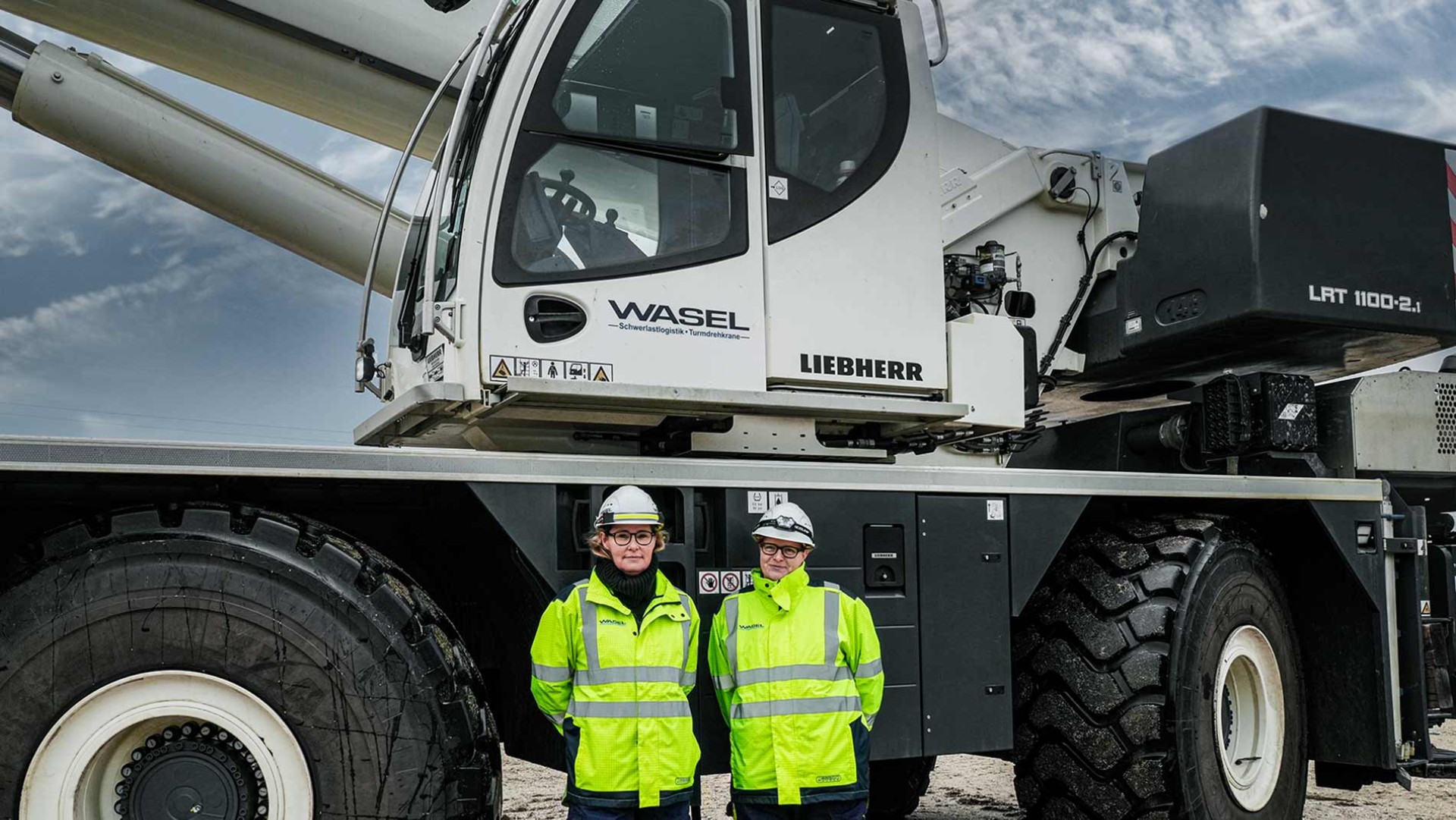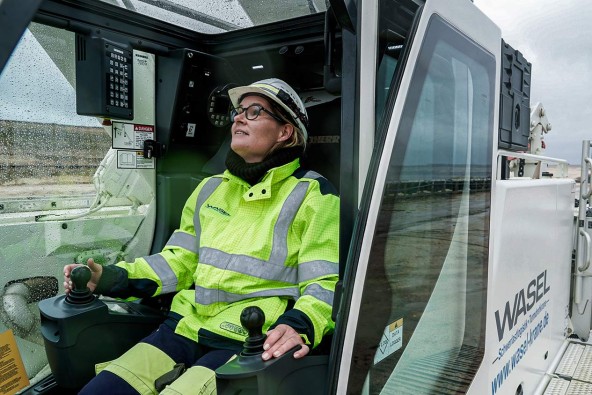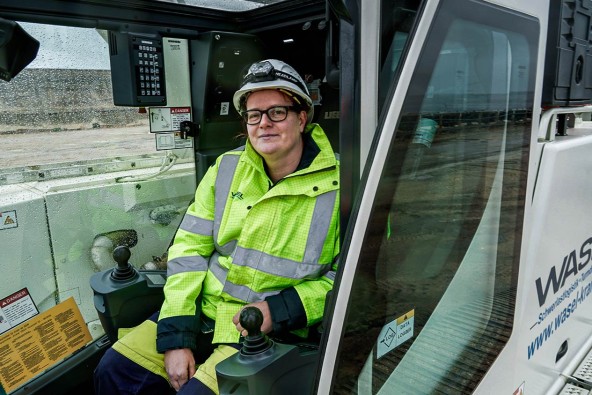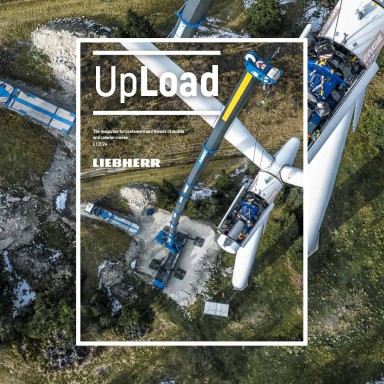
10 minutes - magazine 01 | 2024
Girl power in open-cast mining
Wasel recruits two female crane drivers.
Operating heavy rough-terrain and crawler cranes is no longer the domain of men. Crane rental company Wasel from Bergheim near Cologne has now been able to recruit two female specialists for the cockpit of telescopic cranes in the Rhenish lignite mining area.
RWE Rheinbraun AG is the largest coal-fired power producer in Germany. The Group currently operates four power plants in the Rhenish mining area. Production will continue until 2030 from the Garzweiler, Hambach and Inden open-cast mines. The gigantic bucket wheel excavators and spreaders at the heart of lignite mining are spectacular. But they don’t work without an armada of auxiliary equipment. Telescopic cranes provide important support for maintenance and repairs. Liebherr customer Wasel from Bergheim near Cologne is the crane service provider on site and has been able to employ two women to operate state-of-the-art telescopic cranes for the first time. The subsidiary of the Hagedorn Group is convinced that when it comes to operating large machines, it’s all about brains and a sure instinct for handling the latest technology. Hagedorn launched the “Women in Construction” campaign at the end of 2020 and has been a pioneer in the advancement of women ever since.
On-site visit to the 48 square kilometre Garzweiler open-cast mine, which will supply up to 25 million tonnes of lignite per year until 2030. There we meet Wasel’s crane drivers. Angelina Heinen obtained her HGV driving licence in 2022 and reports: “After I had mastered operating tractors and trucks, I wanted to change careers and drive a crane for Wasel. And since October, that’s exactly what I’ve been doing. With technical understanding and good guidance and support from colleagues at the beginning, the induction process went quickly. My conclusion: I’m sticking with it.” Details were often explained during breaks, tips were given and tricks were shown. But there’s more to it than that. And Rebecca Herkenrath explains: “The necessary knowledge of the many square kilometres of the site, the safety instructions specific to open-cast mining and information about escape routes and assembly points is extensive. There’s a lot more on crane technology on top of that. But the job fulfils me – I like sitting in the cab and being in charge from there.”

Rebecca Herkenrath´s husband is a crane driver at Wasel and has permanently “infected” his wife with the crane virus. Their conclusion: “Liebherr technology is easy to control.”
Rebecca Herkenrath’s reasons for joining Wasel were family-related: “My husband has been working at Wasel on various cranes for years and when the children were growing up, I started looking for a job.” She was already working at Wasel as a temp and, according to her husband’s reports, she applied for a seat on the crane. “I got the job and was quickly burning with enthusiasm.
I enjoy working responsibly with these powerful machines and completing orders.” The “dead times” are a little tough, she explains: “I’m sitting in the LRT cab, the load is attached and little happens for hours because I’m holding a winch in the assembly position with the crane, for example. It takes time for the part to fit and I monitor everything from the cab during this time.”

Angelina Heinen switched from trucks to rough-terrain and crawler cranes and doesn’t regret it for a second. “My colleagues are great and not short of tips.”
Speaking of learning, Angelina Heinen reports: “We practised this very quietly on dry land, so to speak. Fastening and lifting loads, driving with loads – the crane responds completely differently to a car. But it’s fun and I’m really proud when I get down from the crane in the evening, without which the huge open-cast mining excavators wouldn’t work.”
And your male colleagues? “All good,” adds Angelina Heinen: “We were given a great reception. Our instructions are also accepted by external companies and our heavy goods transport drivers – as a woman, you are certainly a little more diplomatic in dealing with them. And there’s full support from the Wasel team.”
Christopher Neuhaus is head of department at Wasel and is responsible for RWE’s fleet of around 11 Liebherr cranes. LTM, LTL, LRT and LTR cranes are in use. “When Rebecca and Angelina approached me and wanted to drive the crane, we said yes straight away. Because they have technical understanding and that alone is important when operating our modern Liebherr fleet. We also have optimal support in Ehingen and are happy to utilise the training opportunities there for our colleagues.”
The two new Wasel employees agree that the telescopic crawler crane is easier to position with a load: “Because we can drive with a load, which makes working on the large open-cast mining equipment in particular much easier.” They are both particularly proud to be able to drive the new LRT rough-terrain crane: After all, this really is a rare and very special crane in Germany.”
The work is varied, with assembly work on large open-cast mining equipment, material loading and many other tasks keeping the blue and white Wasel athletes on their toes. Rebecca Herkenrath tells us: “I really enjoy doing the job – even if you sometimes have to concentrate on the suspended load for hours at night in challenging weather conditions – for example when repairing the large equipment or at belt transfer stations.” Christopher Neuhaus adds: “We are urgently looking for staff, so we are all the more pleased that we now have two new colleagues on board who are happy to sit in the modern cockpits from Ehingen. The operation is super ergonomic and thanks to training and remote instruction from Liebherr, all new team members are optimally prepared – training at the Liebherr plant in Ehingen is already a foregone conclusion.”
This article was published in the UpLoad magazine 01 | 2024.



